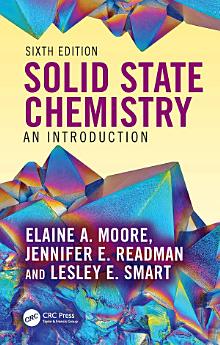Solid State Chemistry: An Introduction, Edition 6
About this ebook
- Excellent overview of solid state properties and syntheses.
- User-friendly style taking a largely non-mathematical approach and giving practical examples of applications of solid state materials and concepts.
- The companion website offers accessible resources featuring topics and tools such as quizzes, videos, web links and more.
- Significantly updated section on sustainability in solid-state chemistry.
- Broad range of topics to provide students with a firm grounding in the major theoretical and practical aspects of the chemistry of solids.
About the author
Elaine A. Moore studied Chemistry as an undergraduate at Oxford University and then stayed on to complete a DPhil in theoretical chemistry with Peter Atkins. After a two-year postdoctoral position at the University of Southampton, she joined the Open University in 1975, becoming a lecturer in Chemistry in 1977, senior lecturer in 1998 and reader in 2004. She retired in 2017 and currently has an honorary position at the Open University. She has produced OU teaching texts in chemistry for courses at levels 1, 2 and 3 and written texts in astronomy at level 2 and physics at level 3. She is the coauthor of Metals and Life (RSC Publishing, 2009) and of Concepts in Transition Metal Chemistry (RSC Publishing, 2010), which were part of a level 3 Open University course in inorganic chemistry and co-published with the Royal Society of Chemistry. She was a team leader for the production and presentation of an Open University level 2 chemistry module delivered entirely online. She is a Fellow of the Royal Society of Chemistry and a Senior Fellow of the Higher Education Academy. She was a co-chair for the successful Departmental submission of an Athena Swan bronze award. Her research interests are in theoretical chemistry applied mainly to solid-state systems and is the author or coauthor of over 50 papers in refereed scientific journals. A long-standing collaboration in this area led to her being invited to help run a series of postgraduate workshops on computational materials science hosted by the University of Khartoum.
Jennifer E. Readman was awarded a BA (Hons) chemistry degree from the University of Oxford and a PhD from the University of Birmingham under the supervision of Dr Paul Anderson. The PhD work involved the use of zeolite frameworks to act as host for metal and metal oxide nanoparticles. The postdoctoral work was carried out at the State University of New York at Stony Brook, where the project involved using 17-O solid state NMR to study zeolites. This work was followed by SINTEF in Oslo, Norway, where the research project investigated carbon dioxide absorbents for use in the clean fuel production. After returning to the UK, Dr Readman returned to the University of Birmingham, working on a joint chemistry/biochemistry project with Dr Joe Hriljac and Prof. Lynne Macaskie, investigating synthetic and bio-manufactured layered phosphates for the remediation of nuclear waste. Before coming to work at UCLan, Dr Readman worked at Durham University under the supervision of Prof. John Evans working on negative thermal expansion materials. Jennifer teaches many different aspects of inorganic and physical chemistry across all year of the undergraduate chemistry programmes. The topics include structure and bonding in inorganic chem-istry, X-ray diffraction, chemistry of the s and p block elements, introductory d-block chemistry, advanced structural techniques, group theory, and advanced materials chemistry. She is the Course Leader for the undergraduate BSc (Hons) and MChem programmes. Her research interests lie in the areas of solid state chemistry, particularly in the relationship between the structure of a material and its properties, such as zeolites, metal-organic frameworks, and metal silicates. Her main research interests also lie in techniques such as powder X-ray diffraction in the laboratory and at synchrotron sources such as the diamond light source. These materials have applications in industry, predomi-nately in the treatment of nuclear and pharmaceutical waste. Dr Readman is also interested in diffuse scattering, electron microscopy, X-ray fluorescence spectroscopy, and solid state NMR.
Lesley E. Smart studied Chemistry at Southampton University, United Kingdom, and after com-pleting a PhD in Raman spectroscopy, she moved to a lectureship at the (then) Royal University of Malta. After returning to the United Kingdom, she took an SRC Fellowship to Bristol University to work on X-ray crystallography. From 1977 to 2009, she worked at the Open University Chemistry department as a lecturer, senior lecturer and Molecular Science Programme director. She held an honorary senior lectureship there until her death in 2016. At the Open University, she was involved in the production of undergraduate courses in inorganic and physical chemistry and health sciences. She was the coordinating editor and the author of The Molecular World course, a series of eight books and DVDs co-published with the Royal Society of Chemistry, authoring two of these, The Third Dimension (RSC Publishing, 2002) and Separation, Purification and Identification (RSC Publishing, 2002). Her most recent books are Alcohol and Human Health (Oxford University Press, 2007) and Concepts in Transition Metal Chemistry (RSC Publishing, 2010). She has an entry in Mothers in Science: 64 Ways to Have It All (RSC Publishing, 2016; downloadable from the Royal Society website). She served on the Council of the Royal Society of Chemistry and as the chair of their Benevolent Fund. Her research interests were in the characterisation of the solid state, and she authored publications on single-crystal Raman studies, X-ray crystallography, Zintl phases, pigments and heterogeneous catalysis and fuel cells.







